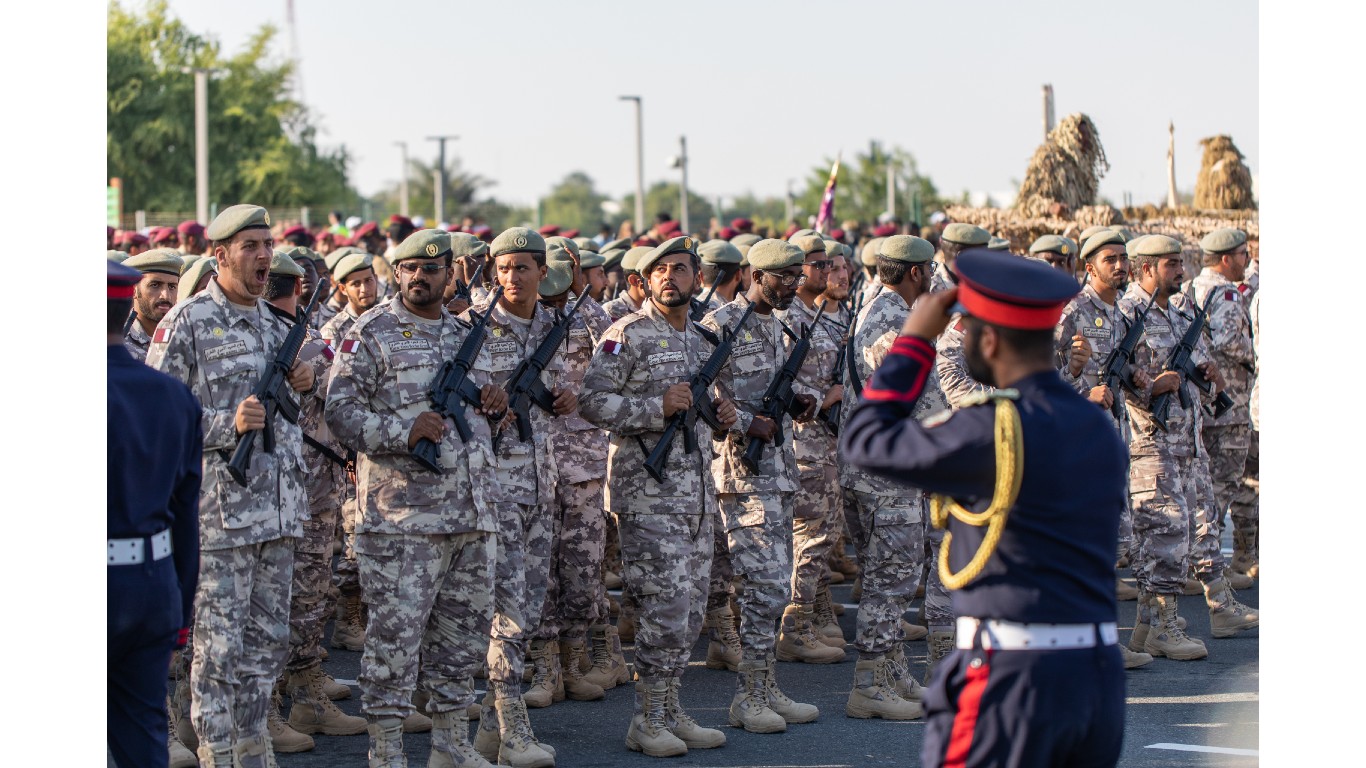
During a visit in early September to the Albanian capital of Tirana, Kosovo President Vjosa Osmani accused Serbia, a close Russian ally, of attempting to destabilize the Western Balkans in order to “attack the values and the system of values on which the U.S. and NATO stand.”
Tensions have flared between the two countries of former Yugoslavia for much of the past two decades over different reasons. And Serbia, almost completely surrounded by NATO member countries, has been strengthening its military in recent years. Serbia, however, is not the only country with growing military power.
To determine the countries growing the most in military power, 24/7 Wall St. reviewed military strength scores from defense reference site Global Firepower — which uses an index composed of over 60 factors, including manpower, military equipment, finances, and membership in alliances such as NATO, to determine a country’s conventional fighting capability. We listed the 25 countries with the largest decline in their Global Firepower Index score — meaning an increase in military power — from 2016 to 2023. Only countries ranking within the 65 most powerful militaries as of 2023 were considered.
Lower Firepower Index scores indicate greater military strength. While a perfect score of 0.0000 is realistically unattainable based on the index criteria, the United States has the world’s most powerful military with a current GFI score of 0.0712. Despite having the most powerful military, the U.S. armed forces’ strength did not increase as much as other countries and the U.S. is not on the list. Meanwhile Serbia’s military, which now ranks 57th most powerful, ranked 82nd most powerful in 2016, as its military strength increased considerably. (See how Russia’s and NATO’s military capabilities compare.)
Seven of the 25 countries with the greatest increases in military power are NATO members. And while all countries on this list increased their military power from 2016 to 2023, the theoretical fighting ability of three countries on this list — Brazil, Iran, and Spain — declined from 2021 to 2023 (as their GFI scores increased).
This list of the world’s growing military powers includes Finland, which joined NATO in April in the wake of Russia’s war in Ukraine. The Nordic country shares an 830-mile border with Russia, part of which is just 120 miles away from St. Petersburg, Russia’s second largest city. Ukraine, meanwhile, had the seventh largest increase in military strength and now ranks as the 15th most powerful in the world. (This nation spent a third of its economy on its military last year.)
Among these 25 countries, four are in Latin America, three are in Southeast Asia, and two are in Africa.
Here are the countries growing in military power.
Click here to see our detailed methodology.
25. Finland
> Change in Global Firepower Index, 2016 to 2023: -0.09
> Global Firepower Index, 2023: 0.81 (50th most powerful in world)
> Global Firepower Index, 2016: 0.90 (54th most powerful in world)
> Active armed forces, 2022: 19,000 (98th largest in world)
> Defense spending as % of GDP, 2022: 2.1% (37th most in world)
[in-text-ad]
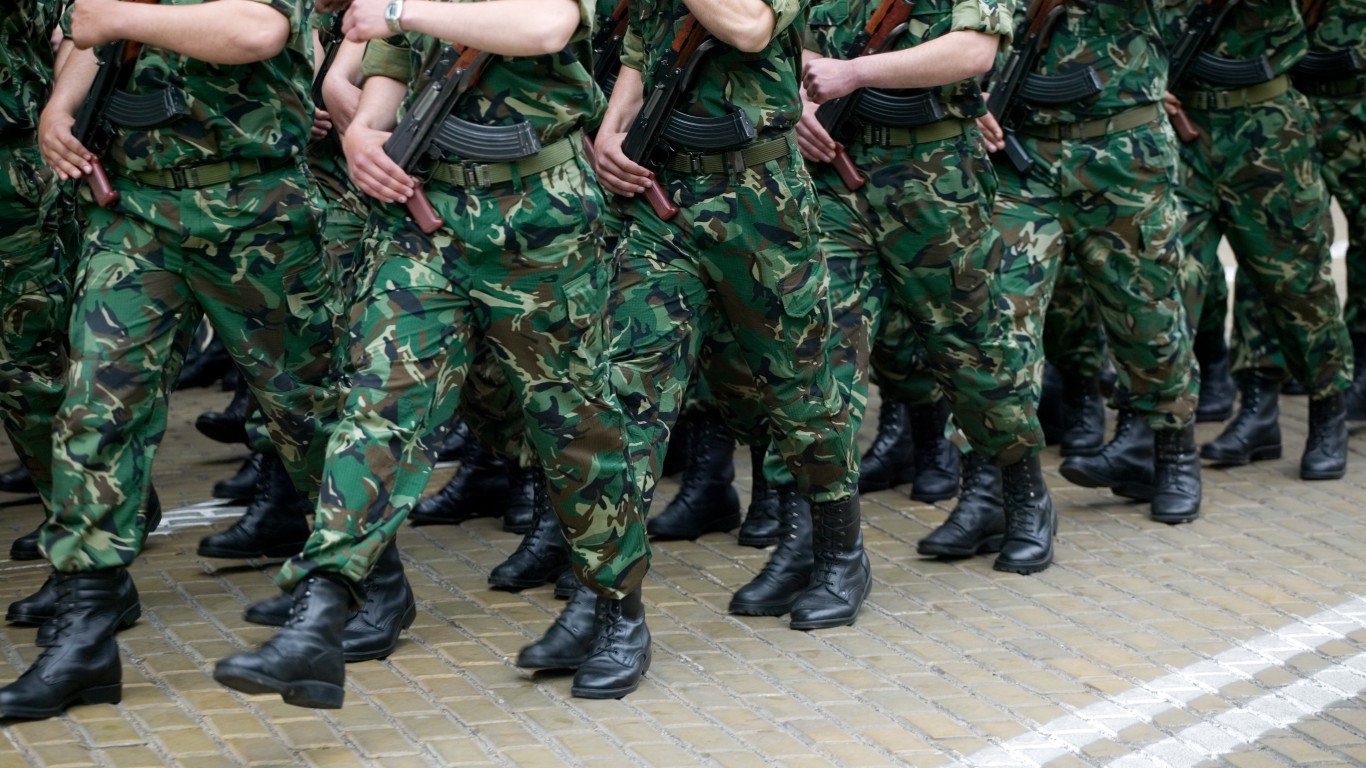
24. Bulgaria
> Change in Global Firepower Index, 2016 to 2023: -0.09
> Global Firepower Index, 2023: 0.98 (58th most powerful in world)
> Global Firepower Index, 2016: 1.07 (66th most powerful in world)
> Active armed forces, 2022: 37,000 (70th largest in world)
> Defense spending as % of GDP, 2022: 1.6% (63rd most in world)
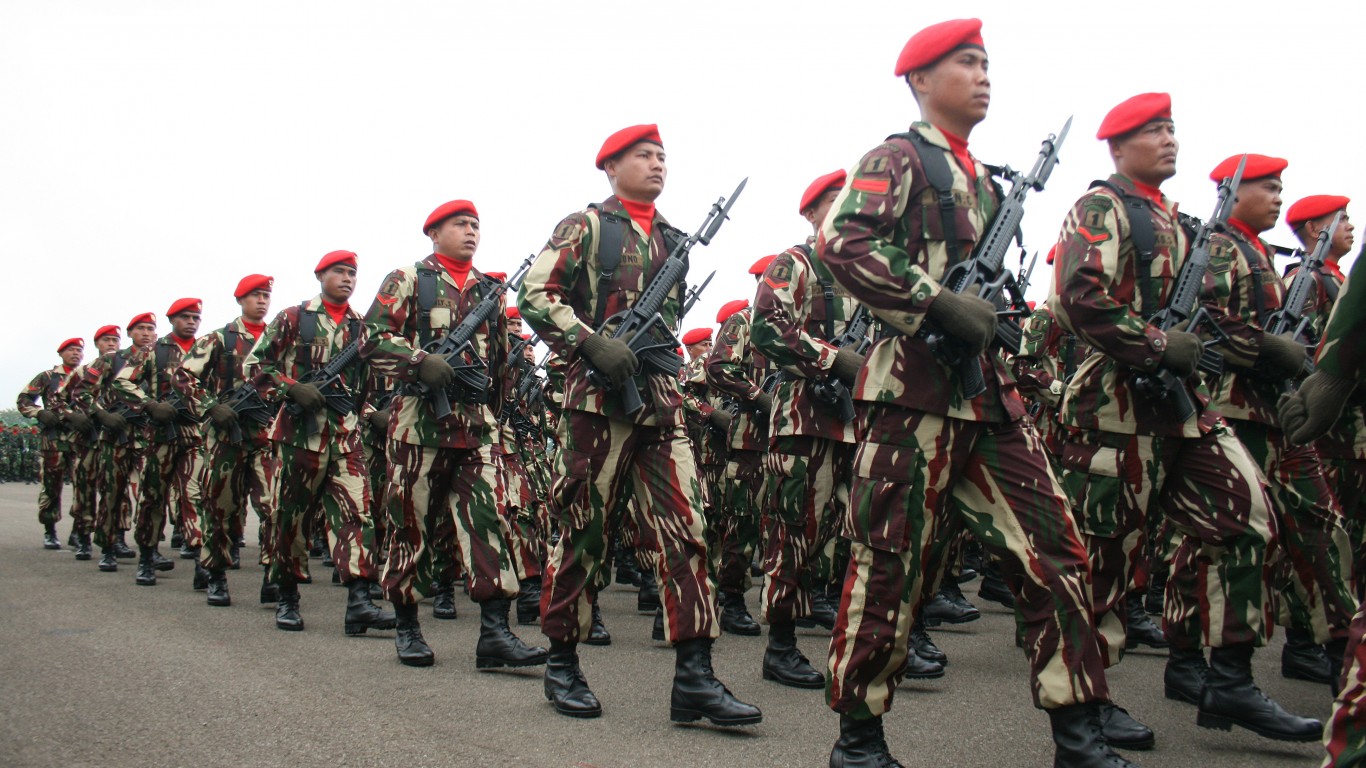
23. Indonesia
> Change in Global Firepower Index, 2016 to 2023: -0.11
> Global Firepower Index, 2023: 0.22 (13th most powerful in world)
> Global Firepower Index, 2016: 0.34 (14th most powerful in world)
> Active armed forces, 2022: 396,000 (13th largest in world)
> Defense spending as % of GDP, 2022: 0.7% (123rd most in world)

22. Brazil
> Change in Global Firepower Index, 2016 to 2023: -0.12
> Global Firepower Index, 2023: 0.22 (12th most powerful in world)
> Global Firepower Index, 2016: 0.34 (15th most powerful in world)
> Active armed forces, 2022: 367,000 (14th largest in world)
> Defense spending as % of GDP, 2022: 1.2% (91st most in world)
[in-text-ad-2]
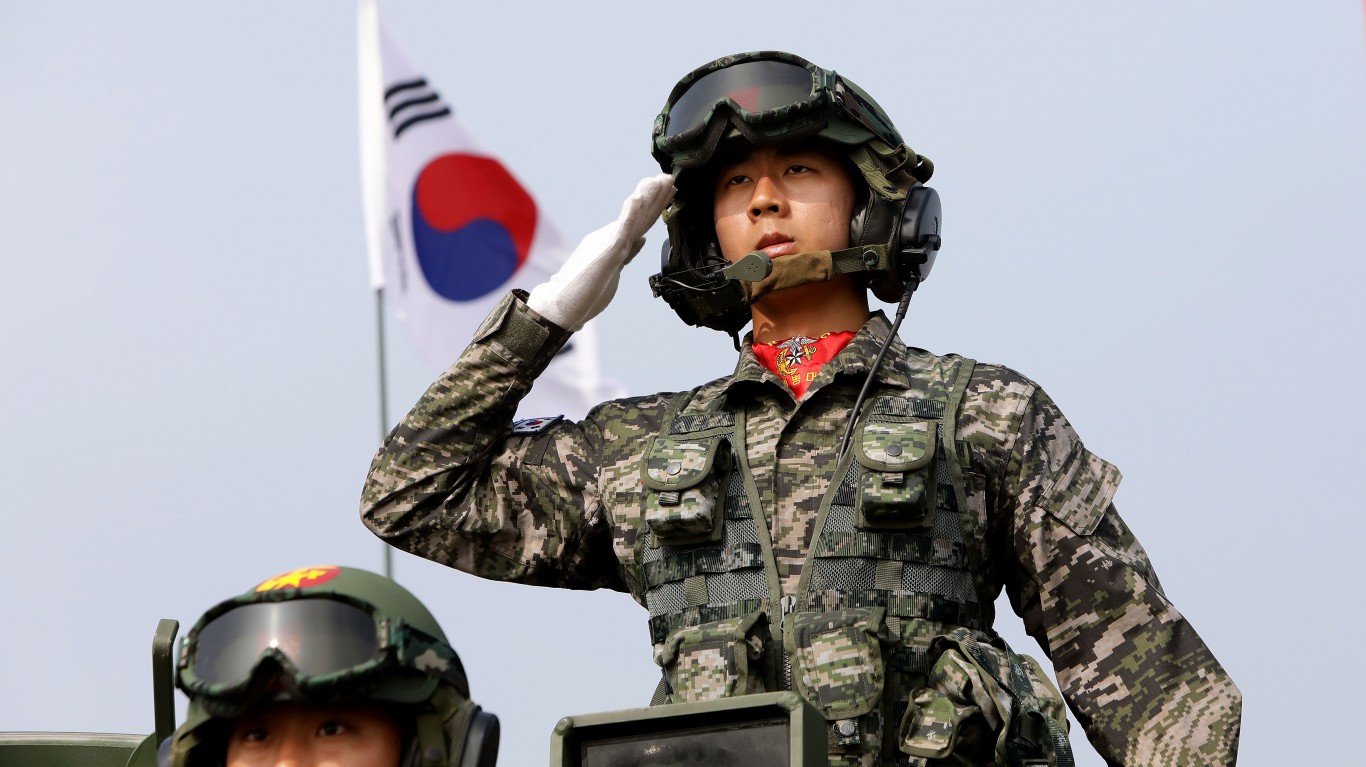
21. South Korea
> Change in Global Firepower Index, 2016 to 2023: -0.13
> Global Firepower Index, 2023: 0.15 (6th most powerful in world)
> Global Firepower Index, 2016: 0.28 (11th most powerful in world)
> Active armed forces, 2022: 555,000 (9th largest in world)
> Defense spending as % of GDP, 2022: 2.5% (27th most in world)

20. Spain
> Change in Global Firepower Index, 2016 to 2023: -0.14
> Global Firepower Index, 2023: 0.36 (21st most powerful in world)
> Global Firepower Index, 2016: 0.49 (26th most powerful in world)
> Active armed forces, 2022: 124,000 (38th largest in world)
> Defense spending as % of GDP, 2022: 1.1% (102nd most in world)
[in-text-ad]

19. Iran
> Change in Global Firepower Index, 2016 to 2023: -0.14
> Global Firepower Index, 2023: 0.27 (17th most powerful in world)
> Global Firepower Index, 2016: 0.41 (20th most powerful in world)
> Active armed forces, 2022: 610,000 (8th largest in world)
> Defense spending as % of GDP, 2022: 2.2% (33rd most in world)
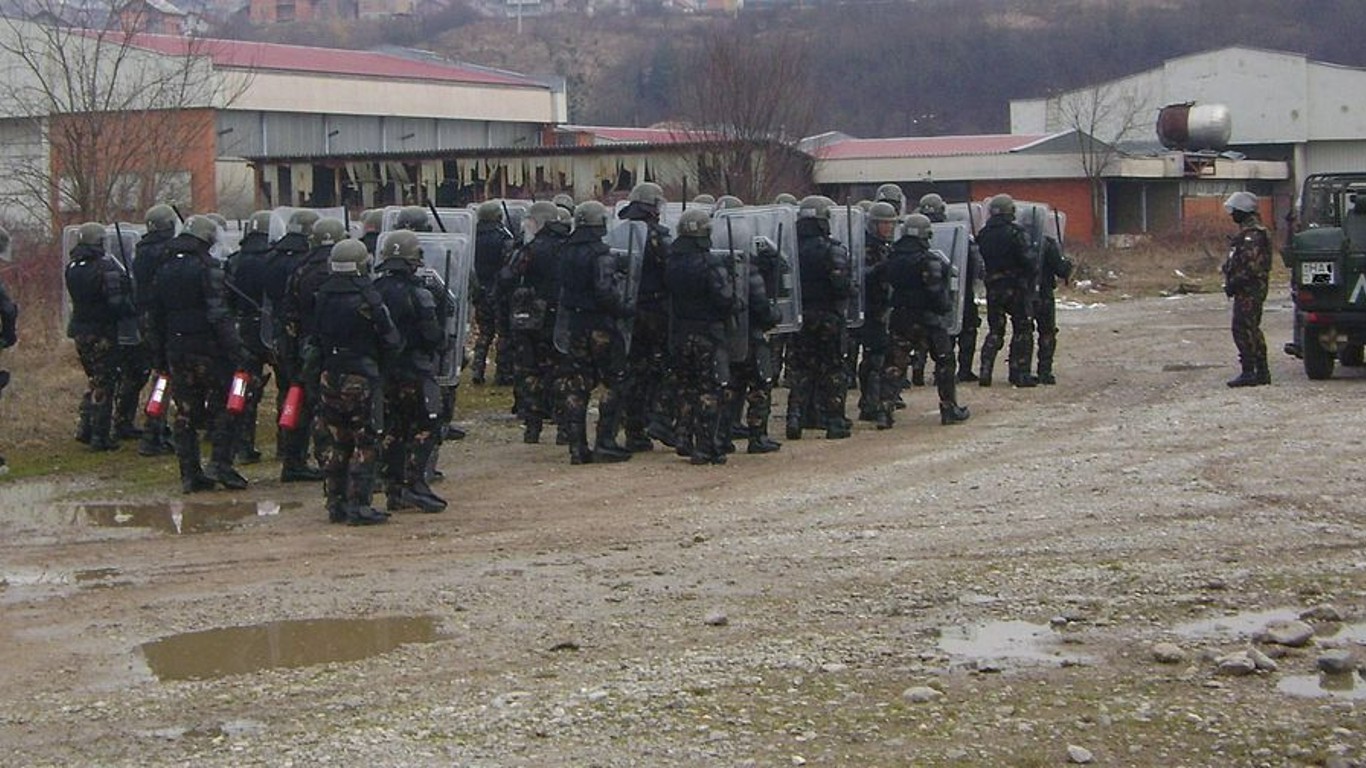
18. Hungary
> Change in Global Firepower Index, 2016 to 2023: -0.14
> Global Firepower Index, 2023: 0.86 (53rd most powerful in world)
> Global Firepower Index, 2016: 1.00 (61st most powerful in world)
> Active armed forces, 2022: 32,000 (78th largest in world)
> Defense spending as % of GDP, 2022: 1.6% (62nd most in world)
17. Netherlands
> Change in Global Firepower Index, 2016 to 2023: -0.14
> Global Firepower Index, 2023: 0.58 (38th most powerful in world)
> Global Firepower Index, 2016: 0.72 (38th most powerful in world)
> Active armed forces, 2022: 34,000 (73rd largest in world)
> Defense spending as % of GDP, 2022: 1.5% (69th most in world)
[in-text-ad-2]

16. Pakistan
> Change in Global Firepower Index, 2016 to 2023: -0.16
> Global Firepower Index, 2023: 0.17 (7th most powerful in world)
> Global Firepower Index, 2016: 0.32 (13th most powerful in world)
> Active armed forces, 2022: 652,000 (7th largest in world)
> Defense spending as % of GDP, 2022: 2.6% (25th most in world)

15. Mexico
> Change in Global Firepower Index, 2016 to 2023: -0.16
> Global Firepower Index, 2023: 0.47 (30th most powerful in world)
> Global Firepower Index, 2016: 0.63 (30th most powerful in world)
> Active armed forces, 2022: 216,000 (23rd largest in world)
> Defense spending as % of GDP, 2022: 0.4% (144th most in world)
[in-text-ad]
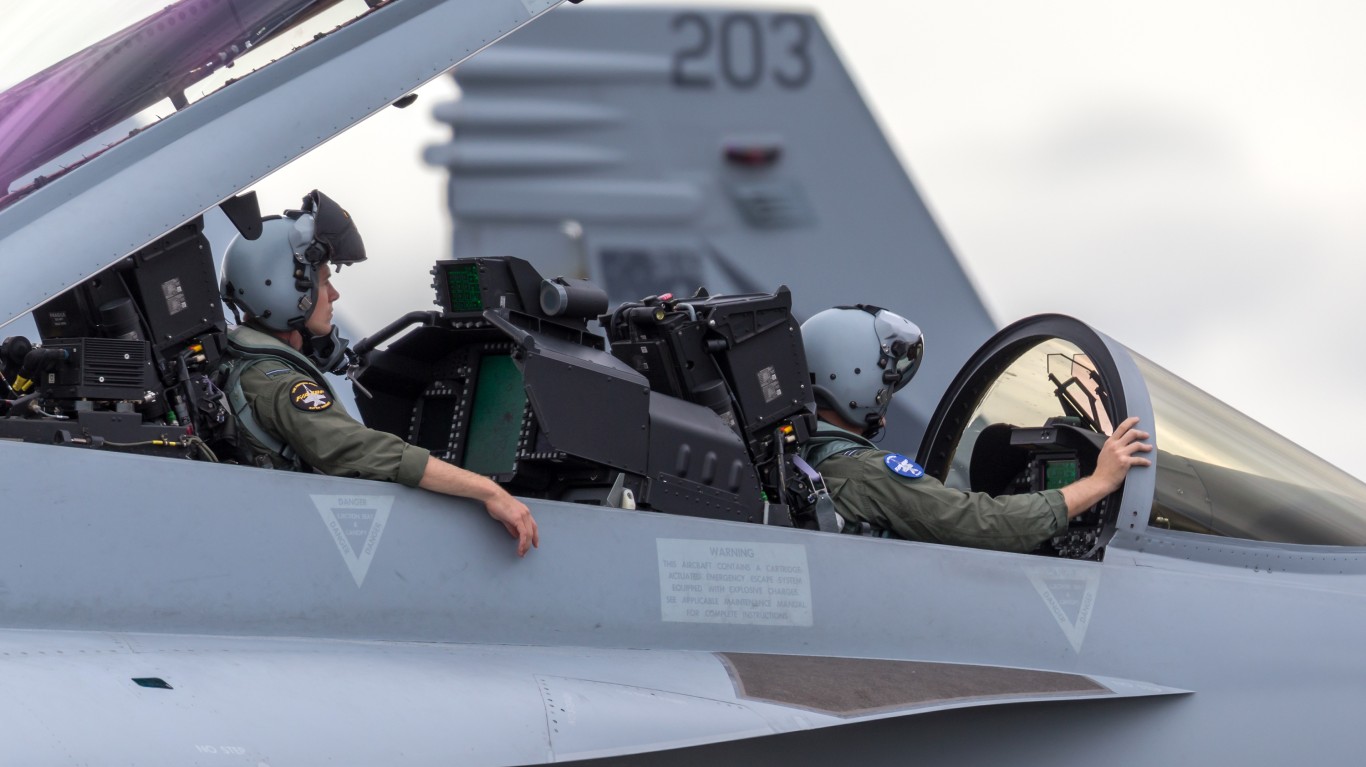
14. Australia
> Change in Global Firepower Index, 2016 to 2023: -0.16
> Global Firepower Index, 2023: 0.26 (16th most powerful in world)
> Global Firepower Index, 2016: 0.42 (22nd most powerful in world)
> Active armed forces, 2022: 60,000 (56th largest in world)
> Defense spending as % of GDP, 2022: 2.0% (41st most in world)

13. Norway
> Change in Global Firepower Index, 2016 to 2023: -0.19
> Global Firepower Index, 2023: 0.53 (34th most powerful in world)
> Global Firepower Index, 2016: 0.71 (37th most powerful in world)
> Active armed forces, 2022: 25,000 (87th largest in world)
> Defense spending as % of GDP, 2022: 1.5% (71st most in world)
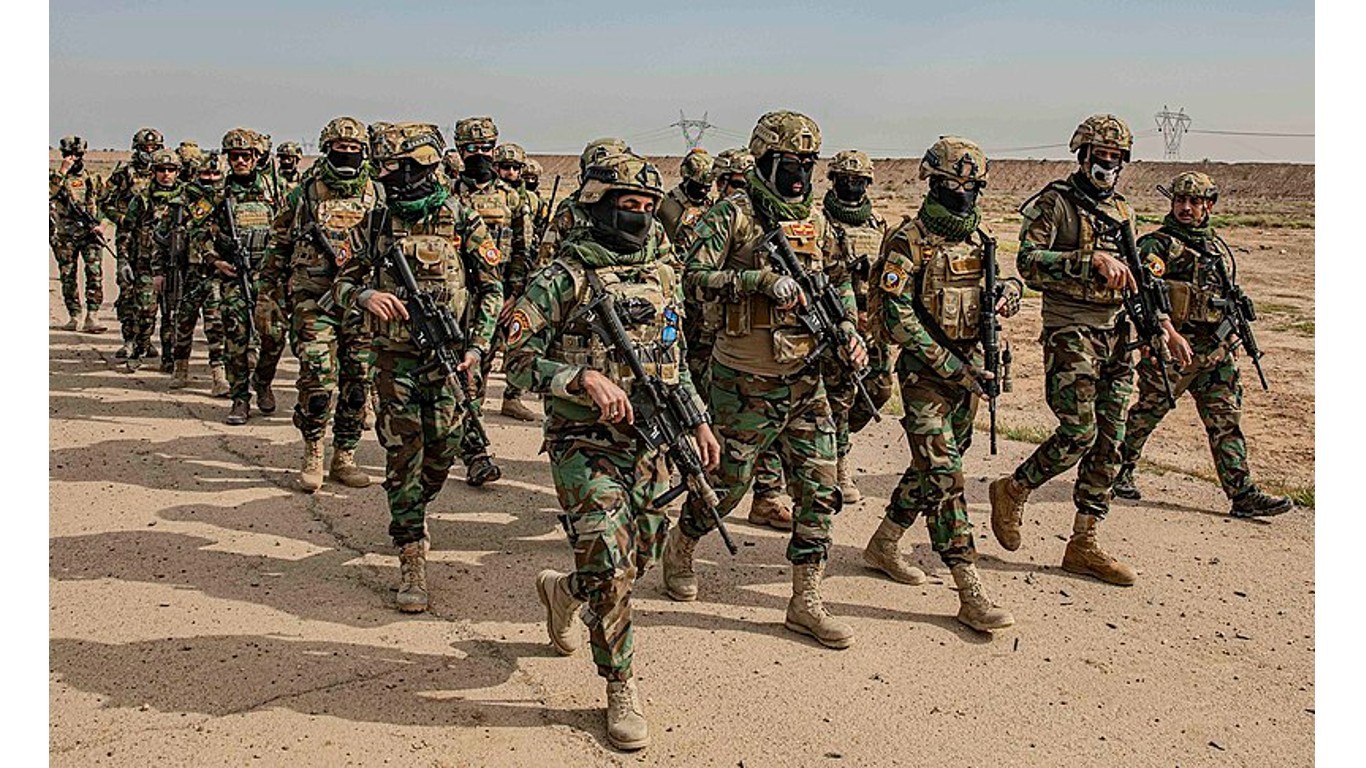
12. Iraq
> Change in Global Firepower Index, 2016 to 2023: -0.20
> Global Firepower Index, 2023: 0.74 (44th most powerful in world)
> Global Firepower Index, 2016: 0.93 (58th most powerful in world)
> Active armed forces, 2022: 193,000 (26th largest in world)
> Defense spending as % of GDP, 2022: 3.2% (16th most in world)
[in-text-ad-2]
11. Nigeria
> Change in Global Firepower Index, 2016 to 2023: -0.23
> Global Firepower Index, 2023: 0.56 (35th most powerful in world)
> Global Firepower Index, 2016: 0.79 (43rd most powerful in world)
> Active armed forces, 2022: 143,000 (34th largest in world)
> Defense spending as % of GDP, 2022: 0.6% (136th most in world)
10. Bangladesh
> Change in Global Firepower Index, 2016 to 2023: -0.28
> Global Firepower Index, 2023: 0.59 (39th most powerful in world)
> Global Firepower Index, 2016: 0.87 (51st most powerful in world)
> Active armed forces, 2022: 163,000 (30th largest in world)
> Defense spending as % of GDP, 2022: 0.9% (108th most in world)
[in-text-ad]

9. Argentina
> Change in Global Firepower Index, 2016 to 2023: -0.28
> Global Firepower Index, 2023: 0.42 (27th most powerful in world)
> Global Firepower Index, 2016: 0.71 (34th most powerful in world)
> Active armed forces, 2022: 72,000 (50th largest in world)
> Defense spending as % of GDP, 2022: 0.5% (137th most in world)

8. Cuba
> Change in Global Firepower Index, 2016 to 2023: -0.31
> Global Firepower Index, 2023: 1.15 (65th most powerful in world)
> Global Firepower Index, 2016: 1.46 (78th most powerful in world)
> Active armed forces, 2022: 49,000 (61st largest in world)
> Defense spending as % of GDP, 2022: N/A

7. Ukraine
> Change in Global Firepower Index, 2016 to 2023: -0.34
> Global Firepower Index, 2023: 0.25 (15th most powerful in world)
> Global Firepower Index, 2016: 0.59 (29th most powerful in world)
> Active armed forces, 2022: 688,000 (6th largest in world)
> Defense spending as % of GDP, 2022: N/A
[in-text-ad-2]
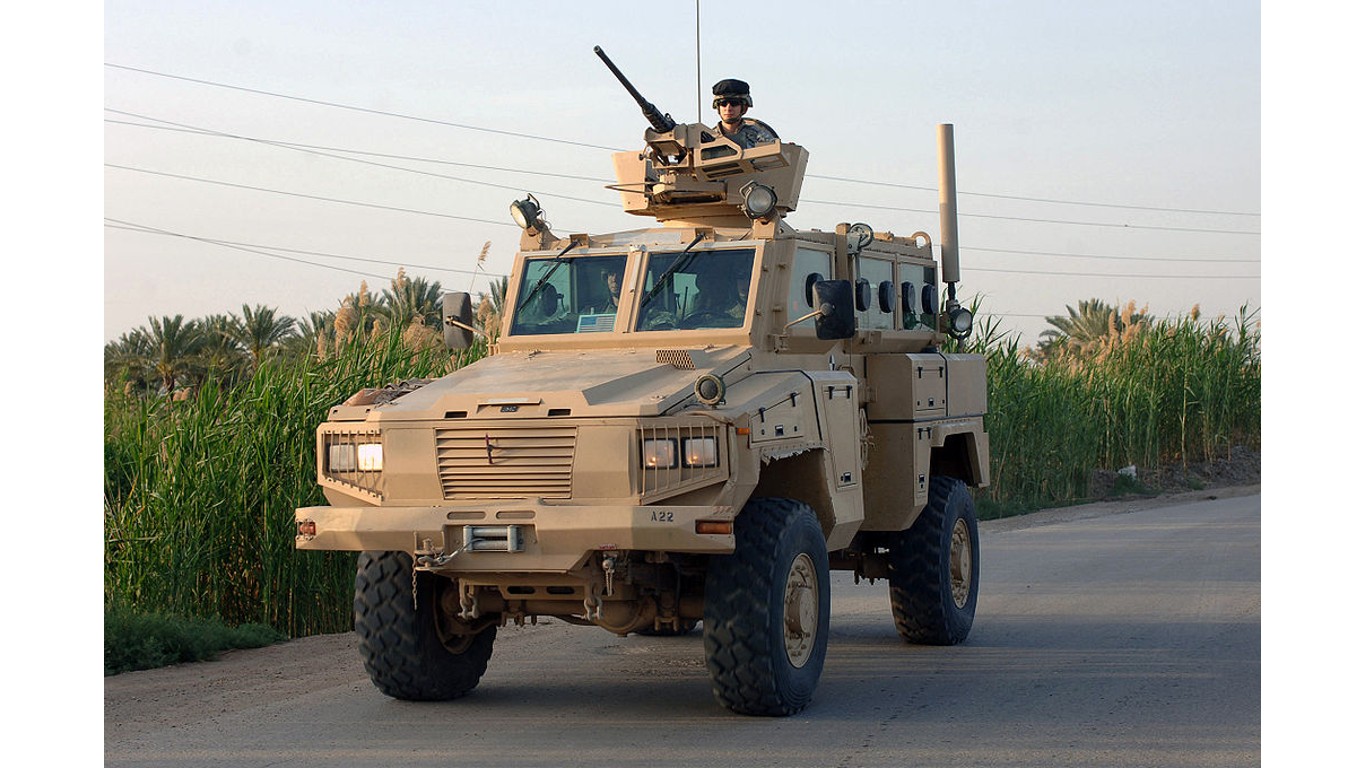
6. South Africa
> Change in Global Firepower Index, 2016 to 2023: -0.34
> Global Firepower Index, 2023: 0.49 (32nd most powerful in world)
> Global Firepower Index, 2016: 0.83 (45th most powerful in world)
> Active armed forces, 2022: 74,000 (49th largest in world)
> Defense spending as % of GDP, 2022: 0.8% (117th most in world)

5. Philippines
> Change in Global Firepower Index, 2016 to 2023: -0.39
> Global Firepower Index, 2023: 0.48 (31st most powerful in world)
> Global Firepower Index, 2016: 0.87 (50th most powerful in world)
> Active armed forces, 2022: 145,000 (33rd largest in world)
> Defense spending as % of GDP, 2022: 1.4% (79th most in world)
[in-text-ad]
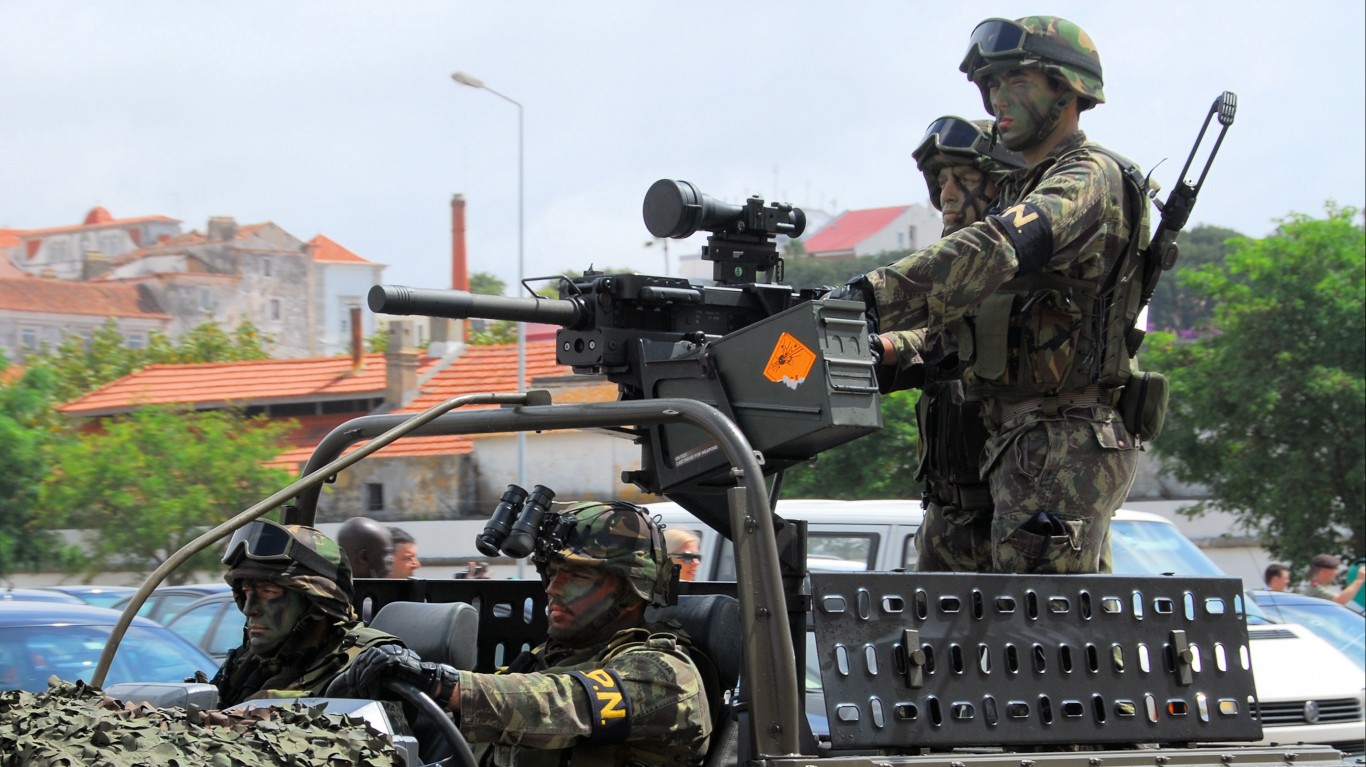
4. Portugal
> Change in Global Firepower Index, 2016 to 2023: -0.41
> Global Firepower Index, 2023: 0.61 (40th most powerful in world)
> Global Firepower Index, 2016: 1.02 (62nd most powerful in world)
> Active armed forces, 2022: 27,000 (83rd largest in world)
> Defense spending as % of GDP, 2022: 1.0% (104th most in world)
3. Singapore
> Change in Global Firepower Index, 2016 to 2023: -0.56
> Global Firepower Index, 2023: 0.46 (28th most powerful in world)
> Global Firepower Index, 2016: 1.02 (63rd most powerful in world)
> Active armed forces, 2022: 51,000 (60th largest in world)
> Defense spending as % of GDP, 2022: 2.8% (23rd most in world)
2. Serbia
> Change in Global Firepower Index, 2016 to 2023: -0.63
> Global Firepower Index, 2023: 0.96 (57th most powerful in world)
> Global Firepower Index, 2016: 1.59 (82nd most powerful in world)
> Active armed forces, 2022: 28,000 (82nd largest in world)
> Defense spending as % of GDP, 2022: 2.0% (44th most in world)
[in-text-ad-2]
1. Qatar
> Change in Global Firepower Index, 2016 to 2023: -0.77
> Global Firepower Index, 2023: 1.13 (64th most powerful in world)
> Global Firepower Index, 2016: 1.90 (92nd most powerful in world)
> Active armed forces, 2022: 17,000 (102nd largest in world)
> Defense spending as % of GDP, 2022: 3.8% (11th most in world)
Methodology
To determine the countries growing the most in military power, 24/7 Wall St. reviewed data on military strength rankings from online defense reference Global Firepower, part of the Military Factory network. Global Firepower ranks countries by military power using an index of over 60 factors, including manpower, military equipment, finances, and membership in alliances like NATO. The lower the Global Firepower Index, the more powerful a country’s theoretical fighting ability. Countries were ranked based on change in Global Firepower Index from 2016 to 2023. Only countries ranking within the 65 most powerful militaries as of 2023 were considered.
Supplemental data on the number of active armed forces and defense spending as a percentage of GDP in 2022 came from the 2023 Military Balance report of the International Institute for Strategic Studies.
The Average American Is Losing Their Savings Every Day (Sponsor)
If you’re like many Americans and keep your money ‘safe’ in a checking or savings account, think again. The average yield on a savings account is a paltry .4% today, and inflation is much higher. Checking accounts are even worse.
Every day you don’t move to a high-yield savings account that beats inflation, you lose more and more value.
But there is good news. To win qualified customers, some accounts are paying 9-10x this national average. That’s an incredible way to keep your money safe, and get paid at the same time. Our top pick for high yield savings accounts includes other one time cash bonuses, and is FDIC insured.
Click here to see how much more you could be earning on your savings today. It takes just a few minutes and your money could be working for you.
Thank you for reading! Have some feedback for us?
Contact the 24/7 Wall St. editorial team.


 24/7 Wall St.
24/7 Wall St.

 24/7 Wall St.
24/7 Wall St.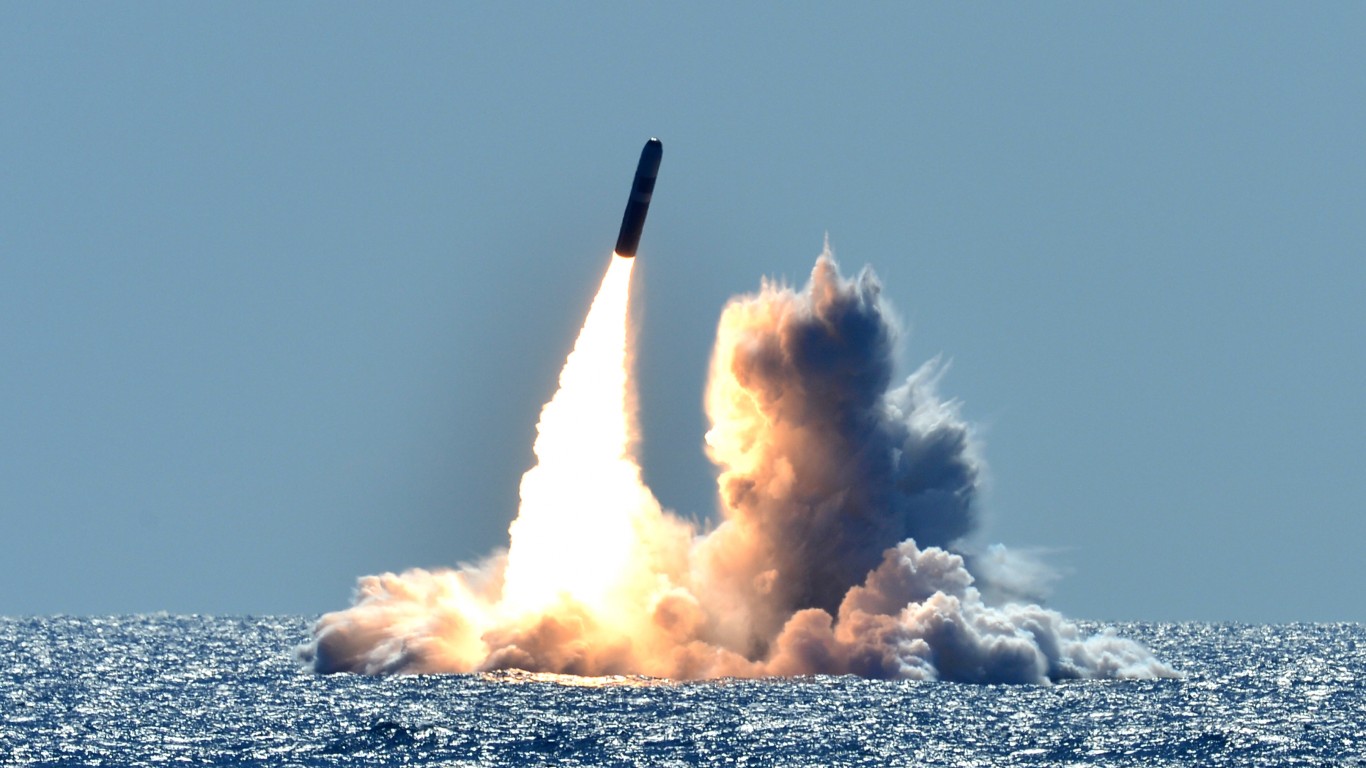 24/7 Wall St.
24/7 Wall St.

